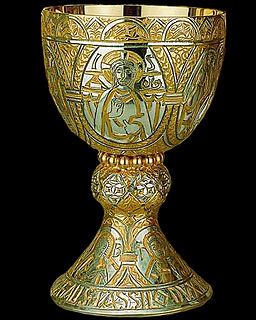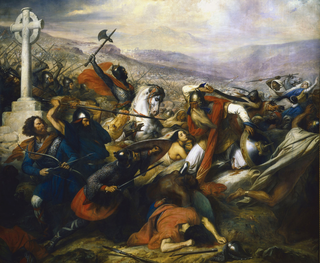The 760s decade ran from January 1, 760, to December 31, 769.

Year 838 (DCCCXXXVIII) was a common year starting on Tuesday of the Julian calendar.

Aquitaine, archaic Guyenne or Guienne, is a historical region of southwestern France and a former administrative region of the country. Since 1 January 2016 it has been part of the region of Nouvelle-Aquitaine. It is situated in the far southwest corner of Metropolitan France, along the Atlantic Ocean and the Pyrenees mountain range on the border with Spain. It is composed of the five departments of Dordogne, Lot-et-Garonne, Pyrénées-Atlantiques, Landes and Gironde. In the Middle Ages, Aquitaine was a kingdom and a duchy, whose boundaries fluctuated considerably.

Septimania is a historical region in modern-day southern France. It referred to the western part of the Roman province of Gallia Narbonensis that passed to the control of the Visigoths in 462, when Septimania was ceded to their king, Theodoric II. The regions was also variously known as Gallia, Arbuna or Narbonensis. Septimania territory roughly corresponds with the modern French former administrative region of Languedoc-Roussillon that merged into the new administrative region of Occitanie. Septimania was conquered by the Muslims in the 8th century and was known as Arbuna and remained part of the Al-Andalus. It passed briefly to the Emirate of Córdoba, which had been expanding from the south during the eighth century before its subsequent conquest by the Franks, who by the end of the ninth century termed it Gothia or the Gothic March.

The Duchy of Aquitaine was a historical fiefdom in western, central and southern areas of present-day France to the south of the Loire River, although its extent, as well as its name, fluctuated greatly over the centuries, at times comprising much of what is now southwestern France (Gascony) and central France.

Pepin the Short, also called the Younger was King of the Franks from 751 until his death in 768. He was the first Carolingian to become king.

Tassilo III was the duke of Bavaria from 748 to 788, the last of the house of the Agilolfings.
Waiofar, also spelled Waifar, Waifer or Waiffre, was the last independent Duke of Aquitaine from 745 to 768. He peacefully succeeded his father, Hunald I, after the latter entered a monastery. He also inherited the conflict with the rising Carolingian family and its leader, Pepin the Short, who was king of the Franks after 751 and thus Waiofar's nominal suzerain.

The Umayyad invasion of Gaul occurred in two phases in 719 and 732. Although the Muslim Umayyads secured control of Septimania, their incursions beyond this into the Loire and Rhône valleys failed. By 759 they had lost Septimania to the Christian Franks, but would return in the 10th century to establish Fraxinet on the Mediterranean coast in France.
Hunald II, also spelled Hunold, Hunoald, Hunuald or Chunoald, was the Duke of Aquitaine from 768 until 769. He was probably the son of Duke Waiofar, who was assassinated on the orders of King Pippin the Short in 768. He laid claim to the duchy following Pippin's death later that year, but his revolt was crushed by Pippin's eldest son, Charlemagne. Hunald fled to the Duchy of Gascony, but he was handed over to Charlemagne and put into captivity. Nothing more is heard of him.

The Siege of Narbonne took place between 752 and 759 led by Pepin the Short against the Umayyad stronghold defended by an Andalusian garrison and its Gothic and Gallo-Roman inhabitants. The siege remained as a key battlefield in the context of the Carolingian expedition south to Provence and Septimania starting in 752. The region was up to that point in the hands of Andalusian military commanders and the local nobility of Gothic and Gallo-Roman stock, who had concluded different military and political arrangements to oppose the expanding Frankish rule. Umayyad rule collapsed by 750, and Umayyad territories in Europe were ruled autonomously by Yusuf ibn 'Abd al-Rahman al-Fihri and his supporters.
The Battle of Toulouse in 844 was part of the campaign by Charles the Bald in Aquitaine to force the submission of Pepin II of Aquitaine, the rebellious son of Pepin, the half-brother of Charles. The historical context of this battle is the three-year Carolingian Civil War, culminating in the Battle of Fontenay-en-Puisaye. Here Charles and Louis the German defeated their brother Lothair I, who retreated to the south with his army.
The Siege of Bourbon was a Frankish siege of the Aquitanian fortress of Bourbon in 761 during the Aquitanian War. The Frankish army under King Pepin the Short invested, stormed and burned the fortress, taking the garrison prisoner.
The Siege of Clermont was a Frankish siege of the Aquitanian fortress of Clermont in 761 during the Aquitanian War. The Frankish army under King Pepin the Short burned the fortress, with a large number of men, women and children dying in the flames. The Count of Auvergne, Bladinus, was taken prisoner and put in chains, while his Gascon levies were killed or captured by the Franks.
The Siege of Bourges was a Frankish siege of the Aquitanian fortress town of Bourges in 762 during the Aquitanian War. The Frankish army under King Pepin the Short invested the fort with lines of circumvallation, contravallation and siege engines. The walls were breached and the fort taken. Count Chunibert of Bourges swore his loyalty to Pepin along with his Gascon levies and their families. Pepin appointed several counts of his own to garrison the place and the Frankish army went on to besiege Thouars.
The Siege of Thouars was a Frankish siege of the Aquitanian stronghold of Thouars in 762 during the Aquitanian War. The Frankish army under King Pepin the Short besieged and captured the fort with great speed, burning the place to the ground, taking the count of Thouars captive and deporting him and Thouars' Gascon levies to Francia.
The Battle of Narbonne was a military engagement near Narbonne in 763 during the Aquitanian War. The forces of the Frankish counts Australdus and Galemanius defeated the Aquitanian forces of Count Mantio, killing Mantio and his retinue in the process and routing the Gascon levies in the Aquitanian service.
The Siege of Toulouse was a Frankish siege of the Aquitanian fortified town of Toulouse in the winter of 767 during the Aquitanian War. The Frankish army under King Pepin the Short conquered the town and accepted the surrender of nearby Albi and Gevaudan.
The Siege of Laon was a Frankish siege of the rebel Grifo's fortified city of Laon in 741. The Frankish army under the Mayors of the Palace, the brothers Carloman and Pepin the Short, besieged the fortress and took Grifo, the Mayors' half-brother, captive.
The Siege of Tortosa was a military campaign by King Louis the Pious of Aquitaine in 808–809. It was part of a decade of intense activity by Louis against the Umayyad Emirate in the region of the lower Ebro. The chronology of his campaigns, which must be worked out from both Latin and Arabic sources, is subject to different interpretations.